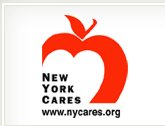Changing Community Service

Maria and I met today with Gary Bagley, the Senior Director of Programs at New York Cares, to brainstom creative ideas about how to run our community service operation.
New York Cares is a non-profit organization that creates volunteer service opportunities for busy New Yorkers -- a total of 183,000 hours of volunteer service in 2005. Their volunteers provide SAT tutoring and computer instruction, serve food at homeless shelters, and lead GED study groups, among many projects.
I have a personal connection to New York Cares: one Saturday a month for several years, I took a group of kids living in temporary housing to a local library as part of the "Read to Me" program.
Community service is a fundamental part of a Bronx Community Solutions sentence, and since July 2005, we've been responsible for scheduling and supervising community service for thousands of mandated offenders. The operation we inherited provided what I would call traditional community service, in which offenders clean parks, train stations and the streets. In addition, we added two crews who patrol the courthouse area, working six hour days and wearing orange vests that say "Bronx Community Solutions."

This is the bread and butter of community service, and it's easy to see why it's attractive. It's cheaper than jail, and the crews do constructive work.
We think we can make community service even more meaningful, however, by increasing the number of sites that take work crews, including community-based organizations like business improvement districts, block assocations, churches and soup kitchens. That's where an organization like New York Cares can help us, because of their contacts in the Bronx.
We also want to use community service as a tool for helping our participants change their behavior, blurring the lines between a traditional community service sentence and social service sentence. Community service will always be hard work (and as a court mandate, it should be), but it can involve more than picking up garbage. For example, our crew supervisors have gotten pretty good at identifying folks who are serious about seeking out long-term, voluntary services like drug treatment or a job placement, because they get to see who shows up on time and is serious about working. They've sent a number of participants to our clinic for a job referral or for other types of services. Our challenge is to turn this ad-hoc process into a more systematic one for all of our community service sites.
Comments
On Bronx Community Solutions own community service crew, we've become experts at connecting clients with community service-only mandates to social services that the clinic provides. In order to expand this practice to our partners, Aeli and I gave a presentation/mini-training this morning to a group of 10-15 crew supervisors and staff at the Department of Transportation on the nuts and bolts of connecting participants to social services through Bronx Community Solutions.
We provided an overview of the services available and described, based on the experiences of our own Crew, how crew leaders might incorporate some of this information into what they say to their clients. Several crew supervisors expressed enthusiasm and interest, saying that this was a "good idea," and asking lots of specific questions about the nature of services. Almost everyone agreed that issues of housing, employment, and health came up often while talking to clients. On the other hand, there were several cynics, who even expressed the opinion that it was "better to know as little as possible about these people's lives," and just focus on getting the work done.
Overall, the training was a success because we did not try to tell experienced people how to do their jobs. Instead, we offered information that we hoped was useful and that might help make their job easier or more satisfying. We'll try a similar approach with some of our other partners.